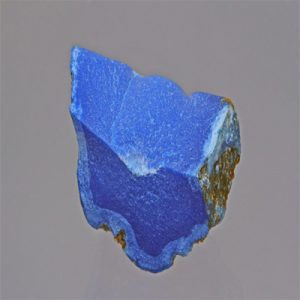Ceruleite
Ceruleite is a very rare arsenate mineral that is rarely found in any size to be fashioned into a gem. It is typically found as extremely minute rodlike crystals or clay-like crusts or concretions covering matrix. The only material that could be used for making a cabochon were small, opaque, solid nodules from a one time find at the Emma Luisa mine, Guanaco, Antofagasta, Chile. Ceruleite is found associated with Mansfieldite and Schlossmacherite at this location. These two minerals are also rare arsenates.
| Chemical Formula: | Cu2Al7(AsO4)4(OH)13•12(H2O) |
| Hydrated Copper Aluminum Arsenate Hydroxide | |
| Molecular Weight: | 1,308.92 gm |
| Composition: | Aluminum | 14.43 % | Al | 27.26 % | Al2O3 |
| Copper | 9.71 % | Cu | 12.15 % | CuO | |
| Arsenic | 22.90 % | As | 35.12 % | As2O5 | |
| Hydrogen | 2.85 % | H | 25.46 % | H2O | |
| Oxygen | 50.12 % | O | |||
| 100.00 % | 100.00 % | = TOTAL OXIDE |
| Crystallography: | Triclinic – Pinacoidal |
| Crystal Habit: | As rodlike crystals, to 5 µm, in powdery to compact, clay-like, massive concretions and in spherical aggregates, to 10 cm. |
| Twinning: | None |
| Cleavage: | None |
| Fracture: | n/a |
| Tenacity: | Brittle |
| Moh’s Hardness: | 5.0 – 6.0 |
| Density: | 2.70 – 2.80 (g/cm3) |
| Luminescence: | None |
| Radioactivity: | Not Radioactive |
| Other: | Readily soluble in acids. |
| Color: | Sky-Blue to pale Blue, Turquoise-Blue |
| Transparency: | Translucent to Opaque |
| Luster: | Vitreous |
| Refractive Index: | n = 1.60 Biaxial ( ? ) |
| Birefringence: | 0.00 |
| Dispersion: | Weak; r < v |
| Pleochroism: | None |


